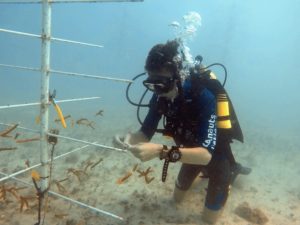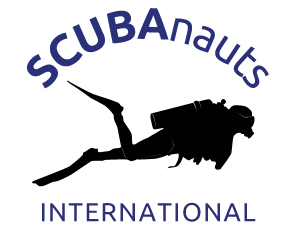The November Keys trip was a very fun and exciting trip,

Nolan M, 2nd Class Naut from the Tarpon Springs Chapter, hangs a coral fragment on a new tree in the Mote Marine Lab coral nursery off Summerland Key, FL.
not only because of the amazing dives we made, but also the fun times we spent together bonding. We completed half of the dives planned for the trip due to poor weather and sea conditions. For the dives that were completed, we all finished the tasks that were asked of us. We made a total of 6 dives on this trip: 2 dives were for coral transplanting where we fragmented and hung over 400 corals in the Mote nursery, 1 dive was made for the moving and permanent laying of Zach Morris’s memorial plaque in the nursery, 2 additional dives were made as training dives for search and recovery, and we had our final dive as a fun dive in the canal.
Coral transplanting was a fun and easy task while working in teams. We had a group of three and a group of two working together with everyone having their own specific tasks. Working in teams made us more productive and able to get more done per dive. Moving coral from tree to tree consists of taking a piece of coral about the size of your pinky and tying a monofilament loop around it and then attaching the piece of monofilament to the tree assigned to transplant the coral to. The corals are transplanted until they are large enough to be placed back into the wild. Transplanting and coral monitoring are important to the redevelopment of coral reefs.
Every trip provides the opportunity to learn something new or to continue to develop better diving skills. While in the coral nursery we focused on continuing to go over the basic skills of diving again, swimming with a current and how to stay in a specific place to not run into the coral trees. The search and recovery course focused on the skills to look for objects in low visibility scenarios, as well as how to use and calculate how much air to put into the lift bag to make the object become neutrally buoyant. We practiced the skills dives in the low visibility of Horseshoe Bay. We deployed our surface marker beacons from a reel, used a lift bag to recover an object from the bottom, and practiced square, u-shape, and circle search patterns.
Although the trip had unforeseen complications that prevented completing the original plan, we were able to transplant coral, place the memorial, have a great tribute to a great young man, and learn something new with the search and recovery specialty course. Every trip with SCUBAnuats provides the chance to learn to adapt to the environment and work as a team to be successful.
— By: Nolan M., Tarpon Springs 2nd Class Naut

